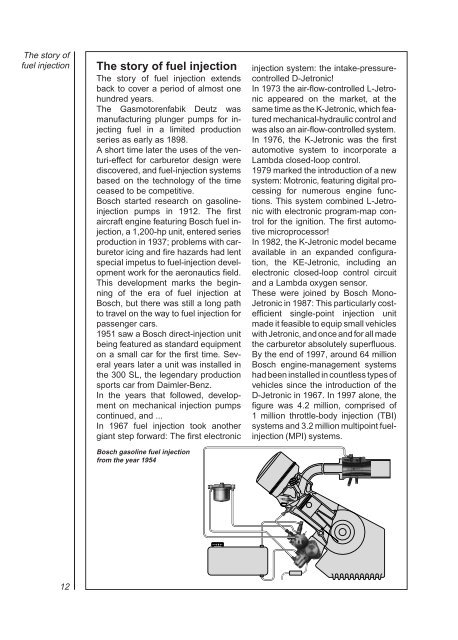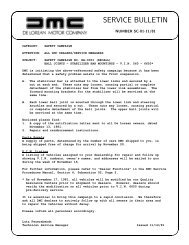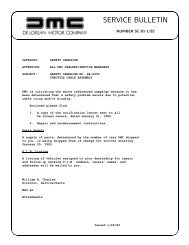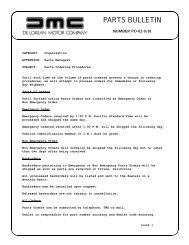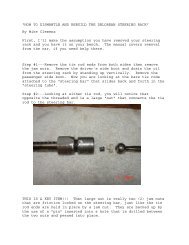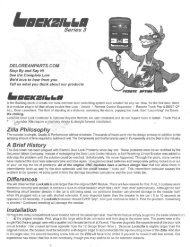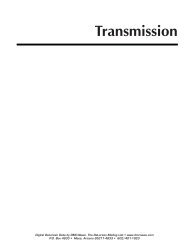Gasoline Fuel-Injection System K-Jetronic
Gasoline Fuel-Injection System K-Jetronic
Gasoline Fuel-Injection System K-Jetronic
Create successful ePaper yourself
Turn your PDF publications into a flip-book with our unique Google optimized e-Paper software.
The story of<br />
fuel injection<br />
The story of fuel injection<br />
The story of fuel injection extends<br />
back to cover a period of almost one<br />
hundred years.<br />
The Gasmotorenfabik Deutz was<br />
manufacturing plunger pumps for injecting<br />
fuel in a limited production<br />
series as early as 1898.<br />
A short time later the uses of the venturi-effect<br />
for carburetor design were<br />
discovered, and fuel-injection systems<br />
based on the technology of the time<br />
ceased to be competitive.<br />
Bosch started research on gasolineinjection<br />
pumps in 1912. The first<br />
aircraft engine featuring Bosch fuel injection,<br />
a 1,200-hp unit, entered series<br />
production in 1937; problems with carburetor<br />
icing and fire hazards had lent<br />
special impetus to fuel-injection development<br />
work for the aeronautics field.<br />
This development marks the beginning<br />
of the era of fuel injection at<br />
Bosch, but there was still a long path<br />
to travel on the way to fuel injection for<br />
passenger cars.<br />
1951 saw a Bosch direct-injection unit<br />
being featured as standard equipment<br />
on a small car for the first time. Several<br />
years later a unit was installed in<br />
the 300 SL, the legendary production<br />
sports car from Daimler-Benz.<br />
In the years that followed, development<br />
on mechanical injection pumps<br />
continued, and ...<br />
In 1967 fuel injection took another<br />
giant step forward: The first electronic<br />
Bosch gasoline fuel injection<br />
from the year 1954<br />
injection system: the intake-pressurecontrolled<br />
D-<strong>Jetronic</strong>!<br />
In 1973 the air-flow-controlled L-<strong>Jetronic</strong><br />
appeared on the market, at the<br />
same time as the K-<strong>Jetronic</strong>, which featured<br />
mechanical-hydraulic control and<br />
was also an air-flow-controlled system.<br />
In 1976, the K-<strong>Jetronic</strong> was the first<br />
automotive system to incorporate a<br />
Lambda closed-loop control.<br />
1979 marked the introduction of a new<br />
system: Motronic, featuring digital processing<br />
for numerous engine functions.<br />
This system combined L-<strong>Jetronic</strong><br />
with electronic program-map control<br />
for the ignition. The first automotive<br />
microprocessor!<br />
In 1982, the K-<strong>Jetronic</strong> model became<br />
available in an expanded configuration,<br />
the KE-<strong>Jetronic</strong>, including an<br />
electronic closed-loop control circuit<br />
and a Lambda oxygen sensor.<br />
These were joined by Bosch Mono-<br />
<strong>Jetronic</strong> in 1987: This particularly costefficient<br />
single-point injection unit<br />
made it feasible to equip small vehicles<br />
with <strong>Jetronic</strong>, and once and for all made<br />
the carburetor absolutely superfluous.<br />
By the end of 1997, around 64 million<br />
Bosch engine-management systems<br />
had been installed in countless types of<br />
vehicles since the introduction of the<br />
D-<strong>Jetronic</strong> in 1967. In 1997 alone, the<br />
figure was 4.2 million, comprised of<br />
1 million throttle-body injection (TBI)<br />
systems and 3.2 million multipoint fuelinjection<br />
(MPI) systems.<br />
12


